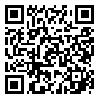1. Samadi F, Dalir M. The role of psychological and social health on sexual health of elderly women. Social Psychology Research. 2021;10(40):21–42.[Persian] [
DOI]
2. Kraus L, Schmid M, In–Albon T. Anti–suicide function of nonsuicidal self–injury in female inpatient adolescents. Front Psychiatry. 2020;11:490. [
DOI]
3. Liu RT. The epidemiology of non–suicidal self–injury: lifetime prevalence, sociodemographic and clinical correlates, and treatment use in a nationally representative sample of adults in England. Psychol Med. 2023;53(1):274–82. [
DOI]
4. Damavandian A, Golshani F, Saffarinia M, Baghdasarians A. Comparing the effectiveness of compassion–focused therapy (CFT) and dialectic behavior therapy (DBT) on aggression, self–harm behaviors and emotional self–regulation in juvenile offenders of Tehran juvenile correction and rehabilitation center. Social Psychology Research. 2021;11(41):31–58. [Persian] [
Article]
5. Victor SE, Hipwell AE, Stepp SD, Scott LN. Parent and peer relationships as longitudinal predictors of adolescent non–suicidal self–injury onset. Child Adolesc Psychiatry Ment Health. 2019;13:1. [
DOI]
6. Esposito C, Bacchini D, Affuso G. Adolescent non–suicidal self–injury and its relationships with school bullying and peer rejection. Psychiatry Research. 2019;274:1–6. [
DOI]
7. Wang SB, Pisetsky EM, Skutch JM, Fruzzetti AE, Haynos AF. Restrictive eating and nonsuicidal self–injury in a nonclinical sample: co–occurrence and associations with emotion dysregulation and interpersonal problems. Compr Psychiatry. 2018;82:128–32. [
DOI]
8. Allen KJD, Hooley JM. Negative mood and interference control in nonsuicidal self–injury. Compr Psychiatry. 2017;73:35–42. [
DOI]
9. Ochsner KN, Gross JJ. The cognitive control of emotion. Trends Cogn Sci. 2005;9(5):242–9. [
DOI]
10. Fox NA, Calkins SD. The development of self–control of emotion: intrinsic and extrinsic influences. Motivation and Emotion. 2003;27(1):7–26. [
DOI]
11. Muehlenkamp JJ, Swenson LP, Batejan KL, Jarvi SM. Emotional and behavioral effects of participating in an online study of nonsuicidal self–injury: an experimental analysis. Clinical Psychological Science. 2015;3(1):26–37. [
DOI]
12. Tang J, Li G, Chen B, Huang Z, Zhang Y, Chang H, et al. Prevalence of and risk factors for non–suicidal self–injury in rural China: Results from a nationwide survey in China. J Affect Disord. 2018;226:188–95. [
DOI]
13. Madjar N, Sarel-Mahlev E, Brunstein Klomek A. Depression symptoms as mediator between adolescents' sense of loneliness at school and nonsuicidal self–injury behaviors. Crisis. 2021;42(2):144–51. [
DOI]
14. Cook NE, Gorraiz M. Dialectical behavior therapy for nonsuicidal self–injury and depression among adolescents: preliminary meta–analytic evidence. Child Adolesc Ment Health. 2016;21(2):81–9. [
DOI]
15. Wester K, Trepal H, King K. Nonsuicidal self–injury: increased prevalence in engagement. Suicide Life Threat Behav. 2018;48(6):690–8. [
DOI]
16. Forket A, Akbari B, Hosseinkhanzadeh AA. Structural patterns of relationships of depression, emotional breakdown, and experience of violence with self–harm behaviors in women: the mediating role of social skills, emotion control, and body dissatisfaction. Social Psychology Research. 2021;11(42):129–55. [Persian] [
DOI]
17. Naderpoor Y, Zare Shahabadi A. The relationship between childhood violence experiences and violence against women in Koohdasht city. Women's Studies Sociological and Psychological. 2015;12(4):93–118. [Persian] [
DOI]
18. Zetterqvist M, Svedin CG, Fredlund C, Priebe G, Wadsby M, Jonsson LS. Self–reported nonsuicidal self–injury (NSSI) and sex as self–injury (SASI): relationship to abuse, risk behaviors, trauma symptoms, self–esteem and attachment. Psychiatry Res. 2018;265:309–16. [
DOI]
19. Sansone RA, Sansone LA. Measuring self–harm behavior with the Self–Harm Inventory. Psychiatry (Edgmont). 2010;7(4):16–20.
20. Bentler PM, Chou CP. Practical issues in structural modeling. Sociological Methods & Research. 1987;16(1):78–117. [
DOI]
21. Tahbaz Hosseinzadeh S, Ghorbani N, Nabavi SM. Comparison of self–destructive tendencies and integrative self–knowledge among multiple sclerosis and healthy people. Contemporary Psychology. 2012;6(2):35–44. [Persian] [
Article]
22. Beck AT, Steer RA, Brown GK. BDI-II manual. San Antonio, TX: The Psychological Corporation; 1996.
23. Beck AT, Steer RA. Manual for the Beck Depression Inventory. San Antonio: The Psychological Corporation; 1987.
24. Stefan–Dabson K, Mohammadkhani P. Psychometrics characteristic of Beck Depression Inventory-Ii in patients with magor depressive disorder. Archives of Rehabilitation. 2007;8(Special Issue: Rehabilitation in Psychotic Disorders & Diseases):80–6. [Persian] [
Article]
25. Haj-Yahia MM. Beliefs about wife beating among arab men from Israel: the influence of their patriarchal ideology. Journal of Family Violence. 2003;18(4):193–206. [
DOI]
26. Mofradnejad N, Monadi M. The relationship of psychological capital and cultural capital with domestic violence in married women. Journal of Woman and Family Studies. 2020;8(1):189–213. [Persian] [
DOI]
27. Inderbitzen HM, Garbin CP. An investigation of the construct validity of the teenage inventory of social skills: a convergent multivariate approach [Internet]. Nebraska: University of Nebraska–Lincoln; 1992 [cited 2023]. Report No.: ED360337. Available from: [
Article]
28. Rasekhinejad M, Khodabakhshi–Koolaee A. Effectiveness of psychodrama on increasing social skills and reducing of aggression in Afghan immigrant labor children. Journal of Pediatric Nursing. 2019;6(2):60–7. [Persian] [
Article]
29. Roger D, Najarian B. The construction and validation of a New Scale for Measuring Emotion Control. Personality and Individual Differences. 1989;10(8):845–53. [
DOI]
30. Roger D, Nesshoever W. The construction and preliminary validation of a Scale for Measuring Emotional Control. Personality and Individual Differences. 1987;8(4):527–34. [
DOI]
31. Yaghoobi P. Investigating the Relationship between emotion expression styles and control attribution style in homemade violence against women with the role of gender stereotypes [M.A. Thesis]: [Tehran, Iran]: Faculty of Psychology and Education, Kharazmi University; 2014. [Persian]
32. Kline RB. Data preparation and psychometrics review. In: Kline RB. Principles and practice of structural equation modeling, 4th ed. New York, US: Guilford Press; 2016. pp:64–96.






